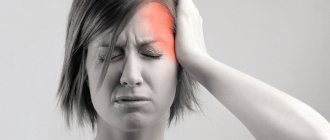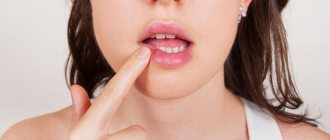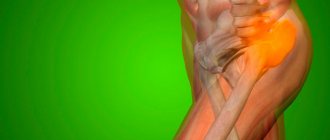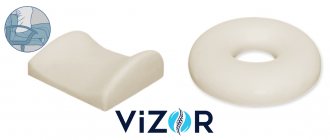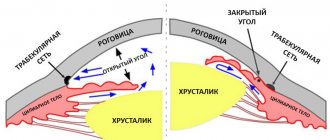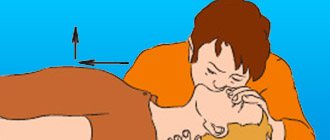We live in a constant abyss of worries: heaps at work, bills for housing and communal services, an atrocious boss and early rises. All this fuss affects the human nervous system and causes headaches. However, not only a busy schedule can cause its appearance; there are many other explanations for this illness.
It is very rare to meet a person who has not experienced a headache. This complaint is one of the most common, according to doctors. And more than 13% of the population of our planet suffers from chronic headaches.
What if your head hurts in your temples?
Temporal headache is the most common type of headache.
Experts attribute the following to the primary reasons:
- neuralgia
- cluster pain
- overvoltage
- migraine
Secondary causes include:
- cerebral vascular damage
- taking medications
- head or neck injury
- non-vascular intracranial lesions
- HIV infection and AIDS
- hemostasis disorder
- pathology of the skull
- psychological illnesses
What to do if you have a headache in your temples? – If this happens for the first time, then you need to take an analgesic. If the pain persists after taking painkillers, you should consult a specialist. If you experience intense and frequently recurring pain in your temples, it is better to consult a therapist or neurologist. If the pain is a consequence of an injury, then you should make an appointment with a surgeon or traumatologist.
Treatment
Conservative therapy
The treatment plan is drawn up taking into account the nature of the disease. The following medications and non-drug methods are used:
- Migraine.
To eliminate paroxysms, non-narcotic analgesics are prescribed. For persistent attacks, blockades are performed. For intense excruciating pain and migraine status, triptans are used in tablets, rectal suppositories, and solutions for parenteral administration. The last two options allow you to solve the problem of taking the drug for persistent vomiting. - Paroxysmal hemicrania.
NSAIDs, glucocorticosteroids, and calcium channel blockers are effective. Depending on the severity of the pathology, medications are taken in short courses or continuously. - Cluster headache.
Painful attacks are eliminated with the help of triptans and applications of local anesthetics to the nasal mucosa. The effectiveness of inhalation of 100% oxygen is noted. Preventive measures in the interictal period are carried out using calcium channel blockers, hormonal, and antiepileptic medications. - Hypnic headache.
The basis of treatment is hypnotics, lithium preparations, and atypical benzodiazepines. Some researchers have reported the effectiveness of steroids and NSAIDs. Before going to bed, patients are advised to take caffeine-containing and melatonin-containing medications. - Vertebrobasilar insufficiency.
Antiplatelet agents, anticoagulants, neuroprotectors, antihypertensive, vascular drugs, exercise therapy, massage, manual therapy, hyperbaric oxygenation, magnetic therapy, laser therapy are recommended. - Tumors.
To reduce the severity of symptoms, non-narcotic and narcotic analgesics, antiemetics, glucocorticoids, and psychotropic drugs are used. Radiation and chemotherapy are carried out as part of palliative therapy or are part of complex treatment in the pre- and postoperative period. - Spinal pathologies.
Pain is eliminated with the help of oral and parenteral forms of NSAIDs, muscle relaxants, and local administration of glucocorticosteroids. They use B vitamins, neurometabolites, phonophoresis, UHF, electrophoresis, and magnetic therapy. - ENT diseases.
Treatment regimens include antibacterial, vasoconstrictor, antihistamines, physiotherapy, paracentesis of the tympanic membrane, and puncture of the paranasal sinuses.
Surgery
Treatment of primary cephalgia is only conservative. For other pathologies, the following may be indicated:
- Vertebrobasilar insufficiency
: reconstructive surgery to restore blood flow. - Brain neoplasia
: removal of cerebral tumors using traditional and minimally invasive surgical techniques. - Spinal diseases
: low-traumatic (endoscopic microdiscectomy, puncture laser vaporization) and traditional (discectomy) interventions for hernias, sometimes in combination with fixation operations. - Pathologies of ENT organs
: sanitizing surgery, mastoidotomy, frontotomy, maxillary sinusotomy, micromaxillary sinusotomy.
What if you have a headache in the back of your head?
Usually such a severe headache chills a person and prevents him from functioning normally. This is a very serious inflammation that you should not experience on your own without medical help. Usually the back of the head hurts due to pathologies. It is better not to try to relieve the disease with analgesics, but to immediately consult a doctor.
Headache in the back of the head can be a signal of diseases:
- nervous system
- vessels
- spine.
Causes of headaches in the back of the head:
- Tension headache. Usually discomfort is associated with tension in the neck muscles. They compress the arteries and nerves that carry blood and impulses to the brain, which is accompanied by a pain reaction in the back of the neck and in the back of the head. In some cases, the provoking factor is emotional tension and stress, which leads to spasm of the neck muscles.
- Migraine is an acute and painful attack of unilateral and occipital headache. An attack can last for several hours or several days. The cause of the disease can be physical activity, overexertion and changes in weather conditions. Most often, women suffer from migraines, and the average age of those affected is from 25 to 35 years.
- Osteochondrosis of the cervical spine is a chronic progressive disease that thins the cartilage in the neck. It can occur after a neck injury, vertebral displacement, sedentary lifestyle or excess weight. The disease can also cause pain in the back of the head.
- Sudden pressure surges.
- Occipital neuralgia provokes an acute headache. Discomfort begins in the occipital region, but can spread to the frontal and temporal lobes. This condition can occur after a neck injury, arthritis, or muscle spasms.
- Use of medications. In self-medication, people “prescribe” themselves medications to treat migraines. This initiative provokes a medicinal headache. It occurs as a reaction of the body to frequent intake of active substances of analgesics.
Pain in the temple area
Arthritis
12357 October 28
IMPORTANT!
The information in this section cannot be used for self-diagnosis and self-treatment.
In case of pain or other exacerbation of the disease, diagnostic tests should be prescribed only by the attending physician. To make a diagnosis and properly prescribe treatment, you should contact your doctor. Pain in the temple area: causes of occurrence, what diseases it occurs with, diagnosis and treatment methods.
Definition _
Pain in the temple area is one of the most common complaints that brings patients to the doctor.
In the bone structures of the skull and brain tissues, pain sensitivity is insignificant, so the main sources of pain are blood vessels, meninges and cranial nerves.
Types of pain in the temple area
According to the International Classification of Headaches 3 (2013), all headaches are divided into:
- for primary pain not associated with diseases of the brain and other structures of the head and neck;
- secondary pain associated with other diseases;
- painful cranial neuropathies, other facial and headaches.
Possible causes of pain in the temple area
Arterial hypertension
is one of the common causes of headaches in the back of the head and temples. When pressure increases, attacks of headaches occur, which may be accompanied by nausea, vomiting, and “spots” before the eyes.
Tension headache
– one of the common reasons for visiting a neurologist and therapist. Patients characterize it as squeezing, pressing.
Tension headaches interfere with quality of life and performance, despite the fact that they are considered benign and do not carry serious consequences.
Migraine
is the most common form of attack-like headache.
Migraine is characterized by localization of pain in the temporo-frontal-orbital region and a paroxysmal nature of the course.
If the pain is not paroxysmal, then it is not a migraine. Seizures can occur on one side of the head or on both sides, and can also change their location (right-left).
A headache attack can occur at any time of the day, more often during a night's sleep in the morning or after waking up. The pain is pulsating, bursting, with a gradual increase in intensity over several hours. Before the onset of an attack, a so-called aura is possible (harbingers of pain, they vary from person to person, but are often described as disturbances in vision, speech, or dizziness). The pain intensifies in bright light, from loud sounds and other irritants, including changes in head position. The attack can last up to several days.
Harris' periodic migraine neuralgia
- characterized by the sudden onset of pain in the eye area on one side and spreading to the temporal, frontal and zygomatic areas, and sometimes even to the neck.
Unlike migraines, there are no warning signs of pain.
The pain is burning, cutting, bursting, accompanied by redness of the eye and lacrimation on the painful side. Some patients experience a sensation of the eye “bulging out of its socket.” All these attacks are characterized by a certain seasonality or periodicity. The duration of the attack ranges from 6–8 weeks to 3 months.
Pain in the temple area may occur immediately after drinking cold water
or ice cream due to arterial spasm. In this case, the pain is aching, squeezing, sometimes throbbing.
Cold pain occurs in individuals with increased sensitivity to cold stimuli and high reactivity of the body.
“Sausage” headache
(in English-speaking authors -
hot dogs headache
) occurs when eating foods containing food additives such as sodium nitrate. During a chemical reaction in the body, nitrate is converted into nitrite, which has a vasomotor effect (controlling the process of contraction and relaxation of the muscular lining of the walls of blood vessels, and, consequently, the lumen of blood vessels), and sensitive people may feel pain in the frontotemporal region.
A similar effect sometimes occurs when eating Chinese dishes (“Chinese restaurant headache”), where monosodium glutamate is often used.
Giant cell arteritis
is the most common systemic vasculitis in the world, affecting large vessels. The favorite localization of this disease is the temporal artery. Most often, the pain is intense, accompanied by limited function of the corresponding temporomandibular joint, blurred vision with its gradual decrease, and a hardened artery in the temple area is detected.
Without treatment, it can lead to permanent blindness of the eye on the affected side.
With inflammatory diseases of the ear,
pain in the temporal and parotid region is possible, which is accompanied by fever, redness, swelling in the ear area, and purulent discharge from the ear.
Meningitis
develops when an infectious agent enters the membranes of the brain, followed by an inflammatory process.
The headache is sudden, sharp, diffuse, predominant in the frontotemporal areas, sometimes accompanied by vomiting.
Neuralgia of the auriculotemporal nerve
often occurs after an inflammatory process or traumatic lesion of the parotid gland. It is characterized by burning, throbbing pain in the area of the external auditory canal, temple, temporomandibular joint, radiating to the lower jaw. The pain is accompanied by increased salivation and redness of the skin over the affected area. Attacks are triggered by eating and smoking.
Neuralgia of the ear ganglion
manifests itself as attacks of burning pain in the temporal region lasting from several minutes to an hour. May be accompanied by ear congestion and increased salivation.
For altitude sickness
There is a change in arterial tone due to reduced oxygen pressure and changes in barometric pressure. Headache is accompanied by shortness of breath, palpitations, and blurred vision.
The severity of symptoms depends on the speed of ascent to altitude.
The pain is relieved by applying cold to the temples and drinking cool water.
Traumatic lesion of the temporal region
may be the cause of pain. This includes a wide group of pathologies: fracture of the temporal bone, dislocation of the temporomandibular joint, soft tissue contusion.
Subarachnoid hemorrhage
occurs for various reasons, for example, as a result of a rupture of a cerebral aneurysm, a person feels like a strong blow to the head, hot liquid pouring into the head, strong contraction, and then bursting. The pain may initially be localized in the corresponding part of the head - in the temporal region when an aneurysm of the internal carotid artery ruptures.
Damage to the temporomandibular joint
(both inflammatory - arthritis, and non-inflammatory - arthrosis, malocclusion) may be accompanied by pain in the parotid and temporal region. When moving the lower jaw, crunching and clicking may occur in the joint; the pain intensifies when chewing and during conversation.
Which doctors should I contact if I have pain in my temples?
If you experience intense and recurring pain in your temples, you should consult a specialist.
If pain persists after taking painkillers or other symptomatic treatment previously prescribed by your doctor (for example, to lower blood pressure), and there are no signs of injury, you should contact or. Depending on the accompanying symptoms, you may need to consult a neurologist, rheumatologist, otolaryngologist, or ophthalmologist. In case of previous injury, it is necessary to contact a traumatologist or to exclude severe injury.
Diagnostics and examinations for pain in the temples
The list of examinations is prescribed by the doctor depending on the indications. An approximate list of studies that may be prescribed:
- computed tomography of the head;
Why does my head hurt and feel nauseous?
Among the causes of nausea and headaches are infectious and non-communicable diseases, pathologies of the nervous and cardiovascular systems. The disease manifests itself due to intoxication and insufficient blood supply to the brain. Typically these symptoms indicate severe fatigue and impairment. This type of headache can also occur during pregnancy.
Causes:
- Overwork and lack of sleep. The body does not have time to recover and rest due to lack of sleep, which leads to negative health.
- Viral diseases that affect body systems and organs. Additional symptoms in such cases will be fever, muscle and joint aches.
- Viral diseases can cause headaches and nausea. For example, flu or sore throat, as well as seasonal infection, can trigger the disease. In this case, experts recommend bed rest and drinking plenty of fluids.
- Lyme disease is an infectious disease caused by a tick bite.
- Pregnancy.
Diagnostics
A neurologist is involved in determining the nature of the disease that provokes pain in the left half of the head. According to indications, a rheumatologist, oncologist, and otolaryngologist are involved. Primary cephalgia (migraine, cluster and hypnic headache, paroxysmal hemicrania) are diagnosed based on clinical symptoms, auxiliary methods are prescribed to exclude organic pathology.
In other cases, when establishing a diagnosis, they rely on both objective data and the results of imaging and laboratory techniques. The examination program includes the following procedures:
- Echoencephalography.
It is produced to measure intracranial pressure and helps to exclude conditions accompanied by intracranial hypertension. Despite the possibility of detecting volumetric processes, in the early stages of tumors it may not be informative due to the small size of the formations. - Assessment of cerebral blood flow
. Includes duplex scanning, ultrasound examination of the vessels of the head and neck. As part of differential diagnosis, it allows you to detect hemodynamic disorders characteristic of atherosclerosis and other diseases. Recommended for patients with vertebrobasilar insufficiency to clarify the nature and structure of the stenosis. - Radiography
. Standard photographs of the cervical spine reveal signs of hernia, osteochondrosis and other diseases of the spinal column. To confirm extravasal compression of the vertebral artery, radiographs with functional tests are taken. For sinusitis, an X-ray of the paranasal sinuses is performed, and for mastoiditis, an X-ray of the temporal bone is performed. - Tomography
. MRI of the brain is prescribed for suspected tumors and arachnoiditis. In angiography mode, it provides comprehensive information about the condition of the main arteries. If a vertebrogenic etiology of pain is suspected, MRI and CT of the cervical spine are performed. For sinusitis, an MRI of the sinuses is sometimes performed.
Consultation with a neurologist
Why does my head hurt in the forehead area?
This phenomenon is quite common in all age groups of the population. Such pain can be acute or chronic, occur independently or in combination with other symptoms. Pain in the frontal lobe occurs even in a healthy person, so their one-time occurrence should not be a cause for concern.
If a person constantly has a headache in the frontal lobes, then there are a number of reasons for this:
- Tension headaches can occur even in healthy people. We must remember that rest is an integral part of the life process. This pain may go away after taking analgesics.
- Eye pain may also spread to the forehead area. The pain begins behind the eyes and spreads to the frontal lobe. Its manifestations are similar to tension headaches: they occur against the background of overwork or active mental work, last from several hours to several days, and are easily relieved with over-the-counter analgesics.
- Sinusitis causes sharp pain in the frontal part of the head and nose. Accompanied by impaired nasal breathing, lacrimation and decreased sense of smell.
- Arteritis is considered the rarest cause of headaches. The disease is associated with inflammation of the walls of large arteries. They become dense and visible above the surface of the skin. The main symptom of the disease is acute pain in the forehead.
Why does my head hurt after sleep?
A morning headache brings discomfort throughout the day. Night sleep is the time when, after a hard day, our body restores strength. But from time to time awakening is overshadowed by unpleasant sensations.
The reason for such an uncomfortable awakening may be:
- Uncomfortable sleeping position.
- Incorrectly chosen pillow or mattress. Ignoring this moment leads to morning pain throughout the body, including the head.
- When the condition of blood vessels deteriorates, blood pressure is disturbed, which affects the quality of our sleep. Then feeling unwell becomes frequent.
- Head injuries can also contribute to headaches in the morning. It can occur a week or a month after the injury.
- Sinusitis makes breathing difficult, which causes a headache when waking up.
- Cervical osteochondrosis is a displacement of the spine in the cervical region. With this disease, the supply of oxygen to the brain is disrupted.
Methods for diagnosing pain in the left hemisphere
To determine why the left side of your head hurts, you will need a full examination. Neurologists diagnose diseases that can lead to this symptom. According to their recommendations, a number of examinations are carried out, the results of which can be informative in determining the cause of the headache and making a diagnosis:
- collecting medical history data - it is important for the doctor to know about the conditions for the occurrence of headaches, its nature and strength, as well as the patient’s lifestyle and habits, old injuries and diseases;
- Ultrasound examination of cerebral vessels (Dopplerography) is a method by which you can evaluate the speed of blood flow and the degree of filling of blood vessels;
- encephalography is a technique that allows you to examine the functional activity of the brain;
- MRI is one of the main diagnostic methods, more often used to identify tumors, but it is also informative for other pathologies.
At the Clinical Brain Institute you can undergo a full examination and determine the cause of your headache. The test results will show a complete clinical picture, on the basis of which it will be possible to select an individual treatment and prevention regimen.
Does paracetamol help with headaches?
Paracetamol is an affordable and time-tested medicine for various types of pain. The drug alleviates the physical condition and has almost no side effects. The medicine helps adults and children, but requires careful dosage when used.
Paracetamol mainly acts as a pain reliever. The phenacetin derivative inhibits the production in the body of compounds responsible for sensitivity to pain - prostaglandins. At the same time, it affects the thermoregulation centers, reducing high body temperature.
Paracetamol is good for relieving headaches in acute respiratory infections. In other cases, it is worth using another analgesic or seeking medical help. In some cases, paracetamol will only dull the pain, but not solve the problem completely.
Treatment of left-sided headaches
Treatment is prescribed only based on the results of the examination. There are various techniques that can be used in the hospital and at home. So, in case of a sudden headache, doctors recommend ventilating the room, doing a neck and head massage, drinking water and taking a short rest. If the discomfort persists, you can take medicine. The most common recommendations from doctors against headaches include:
- painkillers that relieve acute pain - they can be taken at home, but should not be abused unnecessarily;
- antispasmodics - relieve vascular spasm and restore normal blood circulation;
- massage - it’s worth making an appointment with a specialist who will also show you how to reduce pain at home;
- physiotherapy is effective for osteochondrosis, neck diseases and during the rehabilitation period after injuries;
- specific treatment - you may need a course of drugs to strengthen intervertebral discs (chondrol protectors), drugs to normalize metabolism in atherosclerosis and other drugs to treat the underlying disease;
- surgical treatment is rarely used; it may be recommended in the presence of tumors, cysts and foci of sclerosis that interfere with the normal functioning of the brain and tend to increase in size.
The Clinical Brain Institute specializes in the treatment of diseases that manifest themselves as headaches. Qualified specialists of a wide and narrow profile work here, and there is also the opportunity to undergo a full examination, including specific techniques. There are different ways to get rid of a headache, but only a doctor can suggest the most effective and safe one.
